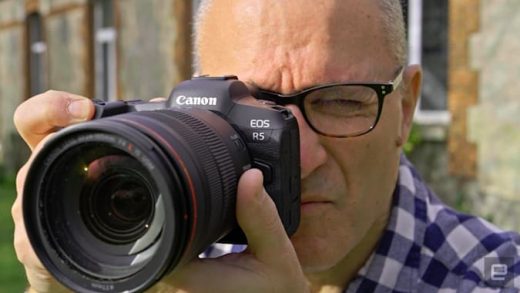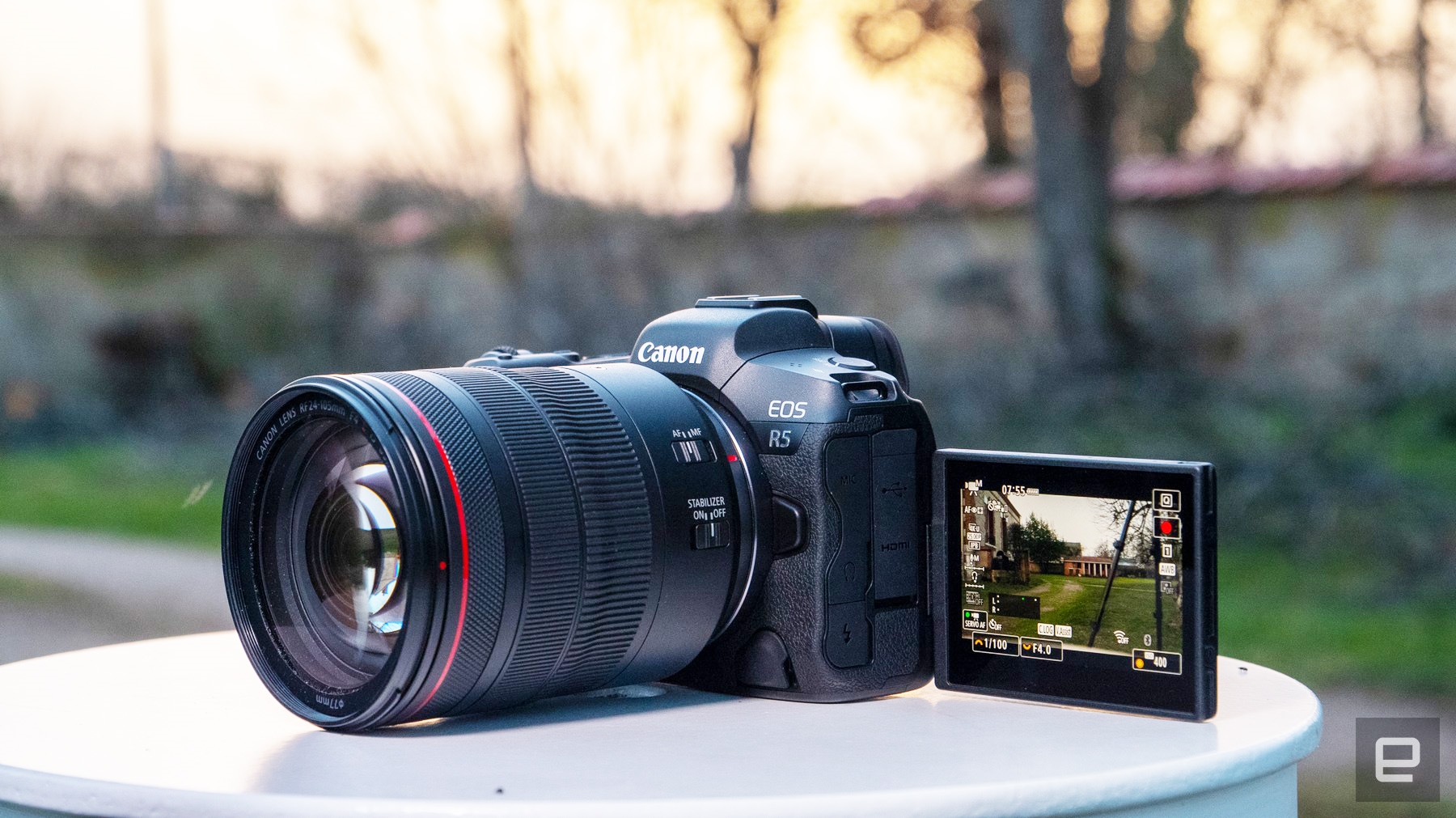Canon EOS R5 review: A powerhouse of a camera with video compromises
Canon EOS R5 review: A powerhouse of a camera with video compromises
It still overheats, but less so than at launch.
As Canon has learned the hard way, innovative products can be criticized as much as celebrated. That was certainly the case with the EOS R5 full-frame mirrorless camera, which launched alongside the EOS R6 to acclaim with groundbreaking features like 8K video. That praise shortly turned sour, though, as reviewers noticed the smallish body had a tendency to overheat, reducing the amount of time you could shoot video with it.
Since launch, however, Canon has introduced firmware updates that have reduced, but not eliminated the heating issues. Even though the camera launched quite a while ago, those have made it a more mature product, while time has allowed the market to better absorb its pros and cons.
EOS R5
87
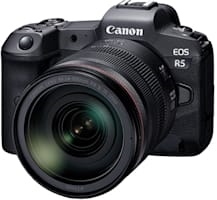
Pros
- 8K 4K 120p video
- Fast and accurate autofocus
- Best-in-class image stabilization
- Great handling
- Sharp and accurate images
Cons
- Video overheating issues
- Micro-HDMI port
- Aging menu system
What got lost in the early fuss is that, on top of its 8K video powers, the EOS R5 is a fast, high-resolution photo shooter. It also offers other innovative features, like powerful in-body stabilization and a much-improved autofocus system, that put it on par or ahead of rivals — especially Sony. With all that and the perspective of time, let’s see how it performs.
Video
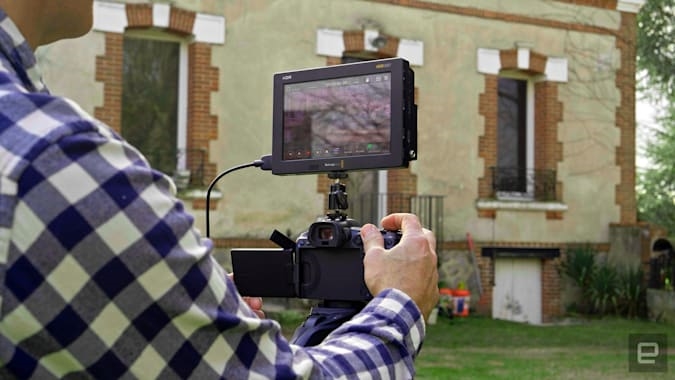
I’ll start with the most exciting and controversial part of this camera: video. The R5 has some extremely powerful video features that few rivals can match, but some unique problems, too. The question is, how does all this affect the average user?
You can shoot 8K 30p or 4K 120p video in high-quality or even RAW modes, directly to an internal memory card. It also supports 10-bit and S-Log recording in all modes.
As Canon puts it, the 8K shooting gives you “extra cropping” or “unique angles alongside a main camera.” What it does not say is that the R5 is a good 8K main camera. That’s mainly because it still overheats, even after the firmware updates.
Canon says you can shoot 8K for 20 straight minutes before the camera will shut off, but I found that it can now go longer — more like 25-30 minutes before I needed to stop. And it recovers more quickly from overheating, so I was able to shoot sooner and for longer after it shut down. When I did shoot 8K for a few minutes at a time and shut down the camera between takes, I was able to shoot for several hours without any issues.
Shooting 4K at 120 FPS is limited to just 15 minutes, but again, I found I could go up to about 20 minutes on a moderately warm day. Canon says you can shoot 4K at 60 fps for 35 minutes with the full sensor, or 25 minutes using an APS-C crop with 5.1K oversampling. Again, I found Canon’s estimates conservative, as I could go 5 to 10 minutes longer.
My biggest concern was with 4K HQ video at 30 fps. This is the mode I prefer, as it oversamples the entire sensor to deliver the sharpest 4K video. I used it to shoot myself for my review video, and was forced to leave the camera turned on while I started and stopped recording remotely with a smartphone. During the 90-minute session, the camera shut down several times.
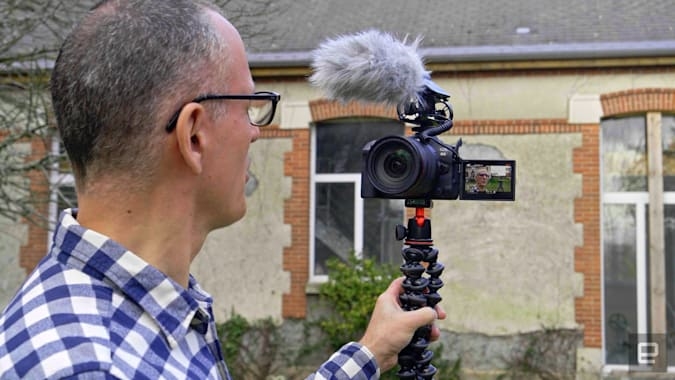
Most of the delays lasted a short time before I was able to shoot again, but a few minutes before the end of my shoot, it went on for some time. I was forced to switch to the regular (non-HQ) 4K mode to complete filming before the sun set.
There are no heating issues when shooting non-oversampled or APS-C cropped 4K (with 5.1K oversampling) at up to 30 fps. If you do that, image quality issues like moire are reduced because the R5 has an anti-aliasing filter. Another option is to capture video to an external recorder from Atomos or Blackmagic Design. If you do that, there are no overheating limitations in any 4K modes, including oversampled HQ.
What does all this mean? The overheating only affects people who shoot 8K or 4K high-frame-rate video all the time. It’s also an issue if you’re shooting long interviews using 4K HQ mode and can’t shut the camera down between takes. If you’re doing any of that, I’d suggest you get a different camera. If you mostly shoot at standard frame rates, with the occasional 8K or 4K slo-mo clip, you’ll rarely need to worry about overheating.
Besides all that, there’s a lot to love about the R5 for video. Canon’s highly effective Dual Pixel video autofocus is available in all 8K and 4K recording modes. It isn’t quite as responsive as the AF on the Sony A7S III, but it’s still very good. You can count on it to follow your subject, even if they’re moving around at a good speed. More importantly, it’s accurate, and doesn’t hunt back and forth for focus.
Canon has also made big improvements to the face and eye-tracking autofocus. It’s now faster and more reliable than ever, and I was comfortable using it in almost any interview or shooting situation with human, and even animal, subjects. It’s not quite up to Sony’s standards in terms of raw speed, but I found the Dual Pixel system made it a bit more reliable.
The EOS R5 also comes with Canon’s five-axis in-body stabilization that offers 8-stops of shake reduction, more than any other mirrorless camera except Canon’s own R6. That’s supplemented by two electronic modes that cause the image to zoom in slightly. The most aggressive mode gave me the smoothest handheld video I’ve ever seen without a stabilizer, but it still can’t stand up to a dedicated gimbal, of course.
Finally, I’m happy to say that rolling shutter is well controlled in regular 4K mode. Even in 4K HQ and 8K, it’s not nearly as bad as earlier Canon and Sony full-frame cameras.
As for video quality, the R5 delivers. I was able to capture insanely sharp footage with accurate colors and skin tones, both in standard and log shooting modes. To really put it to the test, I edited the video that accompanies this review in 4K HDR with a mix of 4K and 8K footage. Viewed on a high-end ASUS 1,000 nit HDR display, I was blown away by the 4K sharpness. (I wasn’t able to post the video in HDR on YouTube as there are still too many issues, especially on macOS.)
To get the most dynamic range, you’ll need to shoot 8K RAW, but you’ll only be able to capture six minutes of that to a 128GB CFexpress card. I still got decent dynamic range shooting 10-bit C-Log files — more than enough for the video.
Moving on from video, let’s not forget that the R5 is a highly desirable camera for photography. The weather-sealed magnesium alloy body oozes quality, and it’s a pleasure to hold and use in general. The grip is nice and large and everything is where you expect it to be.
Canon nuked the impractical touch bar from the EOS R and replaced it with a joystick, so the button layout is more like a typical Canon DSLR. It did keep the EOS R’s handy top display and mode dial, however.
Unlike Sony and Panasonic, Canon hasn’t seen fit to change its aging menu system, so it’s still a bit tricky to navigate. You can use the touchscreen to get to settings quicker, but the menus aren’t really designed for touch operation.
The sharp 2.1 million dot rear display is fully articulating, so you can use it for vlogging or shooting at unusual angles. Sony’s A1 only has a tilting rear display, an odd choice since it’s such a powerful camera for video, so the EOS R5 has a big leg up here.
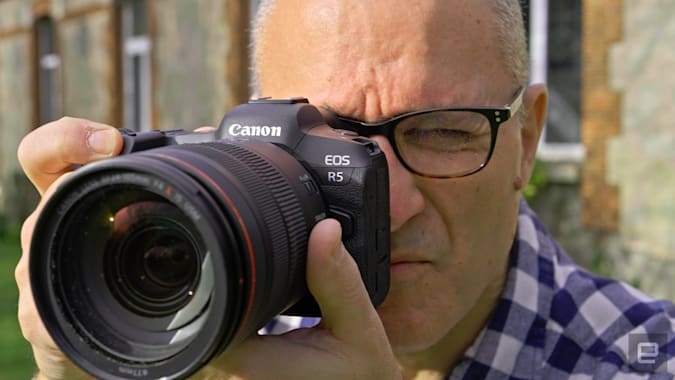
If you’d rather use the electronic viewfinder (EVF), it has a sharp 5.76 million dot resolution and 120 Hz refresh rate. That’s not as good as the 9.44 million dot EVF on the A1, but it’s still plenty sharp and extremely smooth.
If you use it as much for photos as I did, you’ll want to be sure to carry extra batteries, however. It can only handle a mediocre 320 shots with the EVF, or up to 490 shots using the rear display. It takes relatively expensive LP-E6NH batteries, but is compatible with older LP-E6N batteries (used in most recent Canon DSLRs) as well.
It comes with microphone, headphone and charging ports and you can charge and tether via the USB-C port. Considering that many folks will want to use it with an external recorder, it’s disappointing that it packs a micro, rather than a full-sized HDMI port. It takes both high-speed SD UHS II and CFexpress cards, so you can choose either high-performance CFexpress or cheaper SD cards, or both, if you need a backup.
For a high-resolution camera, the EOS R5 offers spectacular performance. You can shoot at up to 12 fps with the mechanical shutter, using both continuous autofocus and auto exposure. In silent electronic shutter mode, it will hit a superb 20 fps. That doesn’t sound as good as the Sony A1’s 30 fps speeds, but in real-world usage, it’s more than quick enough for sports and action photography.
With a fast CFexpress card, I could capture up to 180 RAW images before it started to slow down. That equates to about 9 seconds of shooting in electronic shutter mode, so you’re not likely to miss a shot before the buffer fills.
Better still, the Dual Pixel autofocus kept things sharp at those speeds. That’s thanks to the 100-percent phase-detect sensor coverage, along with new deep learning algorithms. With all that, it can now do eye-, face- and head-tracking for people and animals, plus body tracking for dogs, cats and birds.
As with video, eye- and face-tracking is uncannily accurate for humans of all sizes, including babies. Again, it’s not quite as responsive as Sony’s latest cameras, but the AI eye-tracking is actually more reliable in certain situations, like shooting birds. For other types of animals, my results varied depending on the type and size of dog, for instance.
It had enough dynamic range to let me pull detail from dark and bright parts of an image, though I saw quite a bit of noise in the shadows at higher ISOs. JPEGs are also very detailed, but the noise reduction is a bit aggressive at high ISO settings.
Wrap-up
I really did like the EOS R5, despite the overheating problems, because it suited my style of shooting. For $3,900, it’s the only pure high-megapixel hybrid camera that does photography and video equally well. Other high res cameras can match it for photography, but none come close for video (on paper) except Sony’s A1 — which costs $2,600 more.
It just has a lot to offer — sharp and rich video and photos, awesome autofocus, class-leading image stabilization and superb ergonomics. The overheating was never much of a problem for me, but it certainly could be for you, depending on how you plan to shoot.
Do not get this camera to shoot continuous 8K or even 4K for events or long interviews, where the camera is shooting or powered continuously. For 4K, I’d go with Sony’s A7S III, or for a lot less, Panasonic’s S5 or the Nikon Z6 II. If you’re one of the few who is serious about shooting 8K, you’ll need to jump into a much higher budget category with Sony’s A1 or even RED, Blackmagic Design or other 8K cinema cameras.
For other types of projects, shot mostly at or below 4K 30 fps with occasional 8K or high-frame-rate shooting, I’d personally buy this camera if I could afford it. The latest updates have reduced the overheating issues, it offers numerous other benefits for video shooting and is a great camera for photography.
(36)

